Is the weather affecting your mood? Everyone is familiar with the way the weather can influence wellbeing. This can vary from person to person depending on preference and associations. For example, one person might feel happier on sunny days because they love to go the beach, while another may enjoy the nostalgia of snow during Christmas time. Aside from personal taste, however, there is scientific evidence backing the various ways weather influences mood and mental wellbeing. Understanding the science behind the relationship between weather and mood can help us to better prepare for environmental changes that may influence the way we feel. For those struggling with depression or addiction, paying attention to weather changes and sunlight exposure can go a long way in maintaining motivations and working towards recovery.
Darkness and Depression
A lack of sunlight has always been associated with sad emotions, but only over the last few decades has research been able to better explain why this is. Our bodies are built with an internal clock that has been conditioned through evolution to coincide with the rotation of night and day. In other words, we are programmed to feel alert when the sun is up, and drowsy after it goes down. During the winter months, when days become shorter and it may become dark before you even leave work, this internal clock, known as the circadian rhythm, causes some inconvenient effects. A lack of sunlight prompts the body to produce melatonin, the hormone that induces sleep. Feeling drowsy at work or when you still have tasks to complete in your day can be frustrating and lead to irritability. At the same time, your brain begins to produce less serotonin. Serotonin is the neurotransmitter that helps regulate mood, appetite, and sleep. Without adequate amounts of serotonin while awake, it can be difficult to experience a sense of wellbeing.
Seasonal Affective Disorder (SAD)
Now that a wealth of data has been collected on the effects of sunlight, or lack thereof, experts have classified the associated negative symptoms as a mood disorder. This condition, known as seasonal affective disorder, or SAD, especially affects people living in areas of the world with long winters and entire months without sun. It can, however, occur in any climate. SAD is characterized by symptoms of depression that return around the same time every year. A rare form of SAD is found in people who experience chronic depression during the summer months, but most people with this condition experience symptoms during short days and cold weather.
Weather, Appetite, and Pain
Rainy days are known for contributing to the blues, but science confirms rain may be responsible for several unpleasant bodily changes. The dip in serotonin levels caused by the lack of sun on rainy days can create food cravings, especially for comforting carbohydrates such as bread and pasta. This may in part be a response to symptoms of depression associated with gloomy weather, as carbohydrates temporarily boost serotonin levels and improve mood. This effect, however, is short-lived, and not an advisable way to regularly combat symptoms of depression.
In addition to the changes in appetite associated with dark, rainy days, rain comes with a change in atmospheric pressure that can have painful affects in the body. Pressure in the nerves and joints caused by a shift in bodily fluid in response to the environmental pressure can cause aches and a lack of mobility. This can contribute to a lack of motivation to exercise, which only exacerbates depressive symptoms.
Sun, Cognitive Function, and Creativity
As you may have guessed based on the many negative effects of a lack of sunlight, healthy amounts of sunlight can have various positive effects on mood and brain function. Despite the temperature, spending time outdoors when the sun is shining can increase serotonin production, improve memory, and even spark the creative process. A recent study took a closer look at the exact chemical process in the brain in response to UV exposure from the sun and found that, while there is still much to learn, there is a definite connection between the production of critical neurotransmitters and exposure to sunlight. With more research we may be able to better understand how people who spend a great deal of time indoors or live in low-sun areas are more vulnerable to mental illness, problems with memory and cognition, and addiction. While we may not be able to control the weather, we can walk fully informed into rainy days and winter months, and take steps to better preserve our mental health and improve mood.
Seasonal Affective Disorder & Substance Abuse
Those with SAD are particularly vulnerable to substance abuse, as is anyone living with depression. If you or someone you love is struggling with addiction and mental health issues, now is the time to seek help. At Burning Tree Ranch, we specialize in long-term care that produces real results, especially for those who have experienced relapse. Here you will find a team of qualified and compassionate professionals, ready to help each client through a customized treatment program that addresses all aspects of addiction, including the identification of co-occurring disorders. We know that the journey towards recovery doesn’t end with the conclusion of an inpatient program, which is why we provide extensive aftercare programs to best support our clients during their transition into lasting sobriety. We also know that addiction affects the whole family, and therefore loved ones are encouraged to participate in the recovery process and take advantage of all our support resources. For more information, call us today at 866-287-2877





